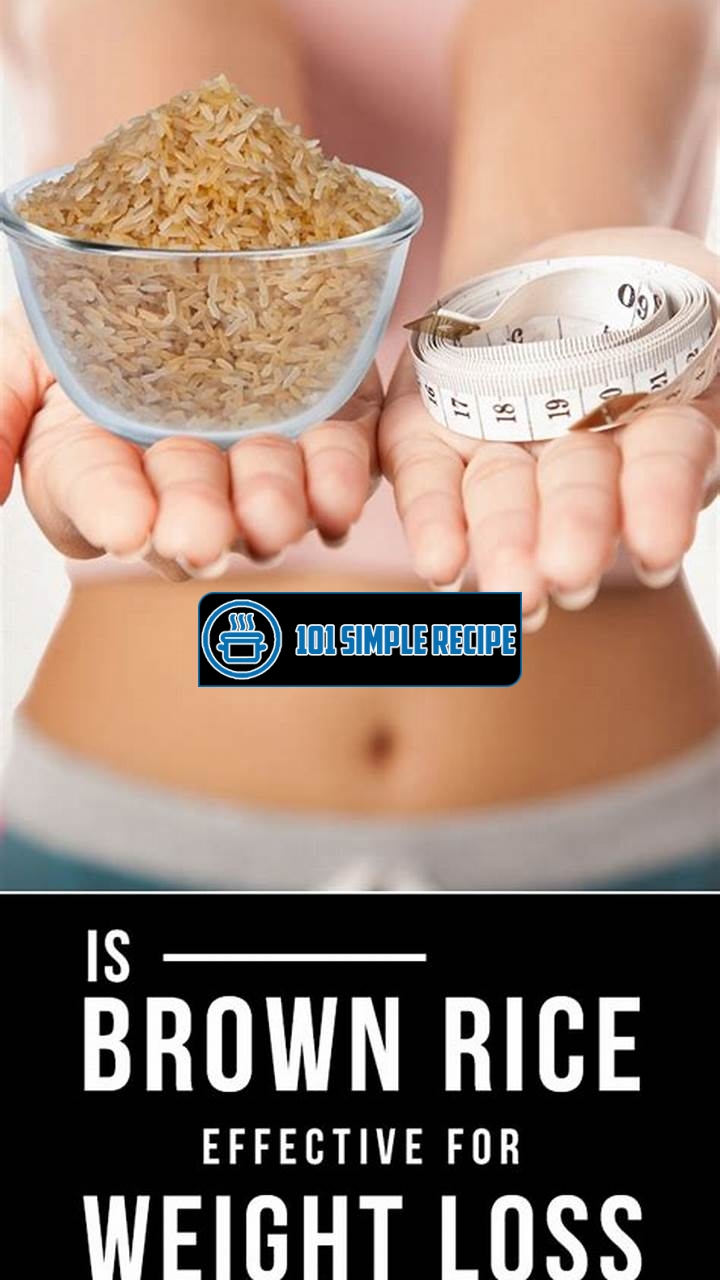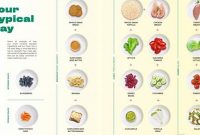Looking to shed a few pounds? ️♂️ Incorporating brown rice into your meals can be a game-changer for your weight loss journey. This versatile and nutritious whole grain is not only a delicious addition to any meal, but it also offers numerous health benefits. In this article, we will guide you through the process of cooking brown rice for weight loss, providing you with valuable tips and tricks along the way. So, let’s dive in and discover the secrets behind using brown rice to achieve your weight loss goals!

The Health Benefits of Brown Rice
Discover the numerous health benefits that make brown rice an excellent choice for weight loss.
Packed with Nutrients
Brown rice is a nutritional powerhouse, packed with essential vitamins and minerals that can contribute to your overall health and well-being. It is a great source of manganese, which plays a crucial role in metabolism and the formation of bone tissue. Manganese also helps in the synthesis of cholesterol, carbohydrates, and proteins, making it an important nutrient for weight loss. Additionally, brown rice contains magnesium, phosphorus, and selenium, which are vital for maintaining healthy bones and teeth.
Furthermore, brown rice is rich in B vitamins, such as thiamin, niacin, and pyridoxine. These vitamins are involved in energy production and help convert food into fuel for our bodies. By including brown rice in your diet, you can ensure that you are getting a good dose of these essential nutrients.
Rich in Fiber
One of the key reasons why brown rice is recommended for weight loss is its high fiber content. Fiber is known to aid digestion, promote satiety, and prevent overeating. It adds bulk to your meals, making you feel full for longer periods, thus reducing the chances of snacking on unhealthy foods. Additionally, the fiber in brown rice can help regulate blood sugar levels, preventing spikes and crashes that can lead to cravings and weight gain.
Fiber also plays a crucial role in maintaining a healthy gut. It acts as a prebiotic, providing nourishment for the beneficial bacteria in your gut. A healthy gut microbiome is essential for proper digestion, nutrient absorption, and immune function. By consuming brown rice regularly, you can support a healthy gut and enhance your weight loss efforts.
Low Glycemic Index
Another advantage of incorporating brown rice into your weight loss diet is its low glycemic index (GI). The GI measures how quickly a food raises blood sugar levels. Foods with a high GI can cause rapid spikes in blood sugar, leading to increased insulin production and fat storage. Conversely, foods with a low GI provide a gradual release of glucose, keeping you satisfied for longer periods and promoting stable blood sugar levels.
Brown rice has a lower GI compared to white rice, meaning it has a more minimal impact on blood sugar levels. This makes it a better choice for weight loss, as it can help control cravings, reduce the risk of developing type 2 diabetes, and support overall metabolic health.
In conclusion, brown rice is a fantastic option for those looking to shed some extra pounds. Its abundance of nutrients, high fiber content, and low glycemic index make it a valuable addition to any weight loss diet. By incorporating brown rice into your meals, you can enjoy the health benefits it offers while working towards your weight loss goals.
Choosing the Right Type of Brown Rice
In order to achieve optimal weight loss results, it is important to choose the right type of brown rice. There are several factors to consider when making your selection, including the whole grain versus parboiled options, organic versus conventional, and different brands and packaging available in the market.
Whole Grain vs. Parboiled
When it comes to weight loss, both whole grain and parboiled brown rice can be beneficial. However, there are slight differences between the two.
Whole Grain Brown Rice:
Whole grain brown rice is the least processed option. It retains the bran and germ layers, making it richer in nutrients and fiber. This helps in promoting a feeling of fullness and aids in digestion, ultimately contributing to weight loss. Additionally, whole grain brown rice has a lower glycemic index compared to parboiled rice, which means it has a minimal impact on blood sugar levels.
Note: If you want maximum nutritional benefits and a lower glycemic index, choose whole grain brown rice.
Parboiled Brown Rice:
Parboiled brown rice goes through a steam and soaking process before the bran is removed. This method helps retain some of the nutrients, such as thiamine and niacin, which are often lost during milling. Parboiled brown rice also cooks faster and has a firmer texture compared to whole grain brown rice.
Note: If you’re looking for a quicker cooking time and a firmer texture, parboiled brown rice is a good option.
Organic vs. Conventional
The decision between organic and conventional brown rice depends on personal preferences and considerations.
Organic Brown Rice:
Organic brown rice is grown without the use of synthetic pesticides and fertilizers. It is also free from genetically modified organisms (GMOs). Choosing organic brown rice minimizes exposure to potentially harmful chemicals and supports sustainable farming practices.
Note: If you prefer a chemical-free and environmentally-friendly option, opt for organic brown rice.
Conventional Brown Rice:
Conventional brown rice is grown using conventional farming methods, which may involve the use of synthetic chemicals such as pesticides and fertilizers. While it is more affordable compared to organic brown rice, it may contain traces of these chemicals.
Note: If you prioritize affordability and availability, conventional brown rice may be the suitable choice for you.
Brands and Packaging
When it comes to choosing brands and packaging, it is important to consider the quality and reputation of the brand, as well as the packaging options available.
Brands:
There are various brands of brown rice available in the market. It is recommended to choose reputable brands that prioritize quality and authenticity. Reading customer reviews and checking for certifications can help ensure the brand’s reliability.
Packaging:
Brown rice is commonly available in both bulk bins and pre-packaged options. Bulk bins allow you to purchase the desired quantity, reducing packaging waste. Pre-packaged options are convenient and come in various sizes, which can be helpful depending on your consumption needs.
Note: Consider the brand’s reputation and packaging options based on your preferences and convenience.
By considering these factors and making an informed choice about the type of brown rice you use for weight loss, you can optimize your results and enjoy the nutritional benefits it offers. Remember to consult with a healthcare professional or registered dietitian for personalized advice tailored to your specific dietary needs and goals.
The Importance of Proper Preparation
Properly preparing brown rice is crucial for enhancing its nutritive value and aiding in weight loss. Brown rice is a whole grain that contains higher levels of fiber, vitamins, and minerals compared to white rice which has had the bran and germ removed. By properly preparing brown rice, you can ensure that you are maximizing its health benefits and optimizing its weight loss properties.
Rinsing and Soaking
To start the preparation process, it is important to rinse the brown rice before cooking. Rinsing brown rice helps remove any dust, debris, or excess starch that may be present on the surface. This not only improves the taste and texture of the cooked rice but also helps remove any impurities that can hinder its nutritional value. Soaking the rice is also beneficial as it helps reduce the cooking time and improves its digestibility.
When rinsing brown rice, measure the desired amount and place it in a fine-mesh sieve or colander. Place the sieve under cold running water and gently rub the rice with your fingers to remove any impurities. Continue rinsing until the water runs clear. After rinsing, transfer the rice to a bowl and cover it with water. Allow it to soak for at least 30 minutes, but preferably overnight for optimal results.
Cooking Techniques
Choosing the right cooking technique is essential for achieving perfectly cooked brown rice. There are several methods you can use, including stovetop cooking, rice cooker, or an Instant Pot.
The stovetop method involves bringing water to a boil in a saucepan, adding the soaked brown rice, and then reducing the heat to a simmer. Cover the saucepan and let the rice cook for about 45-50 minutes or until the grains are tender and chewy. It’s important to note that the cooking time may vary depending on the specific type and brand of brown rice.
If you prefer to use a rice cooker, simply add the soaked rice and the appropriate amount of water to the cooker and follow the manufacturer’s instructions. Rice cookers are convenient as they automatically adjust the cooking time and temperature for optimal results. Another popular option is using an Instant Pot, which offers the advantage of faster cooking times. Simply add the soaked rice, water, and set the pressure cooking mode according to the manufacturer’s instructions.
Seasoning and Flavoring
While brown rice is packed with nutrients, it can sometimes be perceived as bland. Adding seasoning and flavorings can enhance the taste and make it more enjoyable to eat. A popular way to add flavor is by substituting some of the water used for cooking with vegetable or chicken broth. This adds depth and richness to the rice. You can also add herbs and spices such as garlic, turmeric, or cumin during the cooking process to infuse the rice with additional flavors.
Furthermore, incorporating healthy fats such as olive oil or coconut oil can provide a creamy texture and a satisfying taste. These fats also help in the absorption of fat-soluble vitamins present in the rice. Don’t forget to season with salt or other seasonings according to your taste preferences. Remember to use these flavor-enhancing techniques in moderation to ensure you are maintaining a healthy and balanced diet.
To sum up, properly preparing brown rice is crucial in order to maximize its nutritional value and promote weight loss. Start by rinsing and soaking the rice to remove impurities and improve digestibility. Choose the right cooking technique based on your preference and kitchen appliances. Lastly, add seasonings and flavorings to enhance the taste of the rice and make it more enjoyable to eat. By following these steps, you can prepare a wholesome and delicious brown rice dish that contributes to your overall well-being and weight loss goals.
Need a sweet treat without the guilt? Check out this peanut butter muffin recipe that’s perfect for weight loss!
Incorporating Brown Rice into Your Weight Loss Diet
If you’re looking to shed some extra pounds and improve your overall health, incorporating brown rice into your weight loss diet can be a great strategy. Brown rice is a whole grain that is packed with fiber, vitamins, and minerals, making it a nutritious choice for anyone trying to lose weight. To help you make brown rice a staple in your diet, here are some different ways to include it in your meals:
Substituting White Rice with Brown Rice
One of the easiest and most effective ways to incorporate brown rice into your weight loss diet is by substituting it for white rice. White rice goes through a refining process that removes the outer layers, including the bran and germ, which are rich in nutrients. This refining process also strips away the fiber, leaving behind a product that is less filling and has a higher glycemic index. On the other hand, brown rice retains all of its natural goodness, making it a healthier choice for weight loss. So, whenever a recipe calls for white rice, simply swap it with brown rice to boost your nutrient intake and help you feel fuller for longer.
Creating Balanced and Nutritious Meals
Another way to incorporate brown rice into your weight loss diet is by using it as a base for creating balanced and nutritious meals. Brown rice can be paired with a variety of vegetables, lean proteins, and healthy fats to make a satisfying and wholesome dish. For example, you can mix cooked brown rice with grilled chicken breast, steamed broccoli, and a drizzle of olive oil for a complete and nutritious meal. This combination provides a good balance of carbohydrates, protein, and fats, helping you stay full and satisfied throughout the day.
Exploring Brown Rice Recipes
To keep things interesting and prevent boredom, it’s essential to explore different recipes that incorporate brown rice. There are countless creative and delicious recipes out there that feature brown rice as the star ingredient. From stir-fries and risottos to salads and pilafs, the options are endless. You can also experiment with different spices and seasonings to add flavor to your brown rice dishes. By exploring a variety of recipes, you’ll discover new and exciting ways to enjoy brown rice while still achieving your weight loss goals.
Note: Incorporating brown rice into your weight loss diet can be a game-changer. Not only is it a nutritious choice, but it also adds variety and flavor to your meals. So, start experimenting with these different ways to include brown rice in your diet and make it a staple for successful weight loss. Remember to consult with a healthcare professional or nutritionist before making any significant changes to your diet. Stay motivated, and enjoy your journey towards a healthier lifestyle!
For a delicious and nutritious dessert, try this peanut butter cup recipe. It’s a great alternative to traditional sweets.
Pairing Brown Rice with Other Weight Loss Foods
When it comes to weight loss, finding the right combination of foods can make a significant difference in your journey. Brown rice, with its high fiber content and low calorie count, is an excellent choice for those looking to shed some pounds. However, to maximize its weight loss benefits, it’s essential to pair brown rice with other nutritious foods that complement its qualities. In this article, we will explore the ideal food pairings that can help you achieve your weight loss goals when combined with brown rice.
Lean Protein Sources
Protein is a crucial nutrient for weight loss as it boosts metabolism and helps you feel fuller for longer. By pairing lean protein sources with brown rice, you can create a satisfying and nutritious meal that supports your weight loss efforts.
One excellent option is grilled chicken breast, which is low in calories and high in protein. When combined with a serving of brown rice, you get a balanced meal that provides the necessary energy and sustains you throughout the day. Add a squeeze of lemon juice for a refreshing twist.
Another protein-packed pairing is tofu stir-fry with vegetables. Tofu is a vegetarian-friendly source of protein and pairs exceptionally well with brown rice. Toss in some colorful vegetables like broccoli, bell peppers, and carrots to add crunch and nutrients to your meal.
An alternative option is grilled fish, such as salmon or cod. Fish is rich in omega-3 fatty acids, which can aid in weight loss by reducing inflammation and improving insulin sensitivity. Serve the grilled fish on a bed of brown rice and accompany it with steamed greens for a wholesome and delicious meal.
Remember: Incorporating lean protein sources like grilled chicken breast, tofu stir-fry, or grilled fish into your meals with brown rice can help promote weight loss and keep you feeling satisfied.
Hearty Vegetables
Adding vegetables to your brown rice dishes not only enhances the taste but also provides essential vitamins, minerals, and fiber. The fiber content in vegetables contributes to feelings of fullness, which is beneficial for weight loss.
One great pairing is stir-fried vegetables with brown rice. Start by sautéing a mix of colorful vegetables like spinach, broccoli, mushrooms, and onions in a small amount of olive oil. Season with herbs and spices for added flavor. Mix in the cooked brown rice, and you have a delicious and nutritious meal ready in no time.
Another option is roasted vegetables with brown rice. Toss vegetables like sweet potatoes, Brussels sprouts, and zucchini in olive oil and roast them in the oven until tender. Serve alongside a serving of brown rice, and you have a satisfying meal that is packed with vitamins and minerals.
For a refreshing and vibrant twist on your brown rice dishes, consider pairing it with a fresh salad. Combine chopped cucumbers, tomatoes, lettuce, and radishes with a simple vinaigrette dressing. Serve the salad over a bed of brown rice for a light and satisfying meal full of fiber and nutrients.
Remember: Adding hearty vegetables such as stir-fried vegetables, roasted vegetables, or a fresh salad to your brown rice meals can elevate their nutritional value and aid in weight loss.
Healthy Fats
Contrary to popular belief, not all fats are bad for weight loss. In fact, incorporating healthy fats into your diet can be beneficial as they help you stay satiated and absorb certain vitamins. By pairing brown rice with healthy fat sources, you create a well-rounded meal that supports your weight loss journey.
Avocado is a versatile and nutritious choice for adding healthy fats to your brown rice dishes. Simply slice a ripe avocado and serve it alongside a serving of brown rice. The creamy texture of avocado complements the nuttiness of brown rice perfectly.
An alternative option is adding a drizzle of olive oil to your cooked brown rice. Olive oil is rich in monounsaturated fats, which can help improve heart health and promote weight loss. Sprinkle some herbs and spices on top for an extra burst of flavor.
Another delicious pairing is nuts and seeds with brown rice. Almonds, walnuts, chia seeds, or flaxseeds can add a delightful crunch to your brown rice dishes while providing the healthy fats your body needs. Sprinkle a handful of your favorite nuts or seeds over a bowl of brown rice for a satisfying and nutritious meal.
Remember: Including healthy fats like avocado, olive oil, and nuts or seeds in your brown rice meals can enhance their taste and contribute to your weight loss efforts.
In conclusion, combining brown rice with other weight loss foods can enhance its nutritional value and maximize its benefits. By pairing brown rice with lean protein sources, hearty vegetables, and healthy fats, you create balanced and satisfying meals that support your weight loss goals. Experiment with different food combinations and flavors to find the ones that suit your taste preferences while still promoting a healthy lifestyle.
If you’re looking for more healthy recipes, try this brownie cookies recipe.
Thank you for taking the time to read this article on how to cook brown rice for weight loss. We hope you found the information helpful and informative. Incorporating brown rice into your diet can be a healthy and delicious way to support your weight loss goals. Remember to visit again later for more tips and recipes to help you on your journey. Happy cooking!
Frequently Asked Questions
Here are some frequently asked questions about cooking brown rice for weight loss:
| No. | Questions | Answers |
|---|---|---|
| 1. | Is brown rice better for weight loss than white rice? | Yes, brown rice is generally considered better for weight loss than white rice. It is higher in fiber and nutrients, and has a lower glycemic index, which means it helps keep you feeling full and satisfied for longer. |
| 2. | What is the recommended cooking method for brown rice? | The recommended cooking method for brown rice is to use a ratio of 2 cups water to 1 cup rice, and simmer it on low heat for about 45-50 minutes, or until the rice is tender and the water is absorbed. |
| 3. | Can you add flavor to brown rice? | Yes, you can add flavor to brown rice by cooking it in broth instead of water, or by adding herbs, spices, and vegetables to the cooking water. |
| 4. | How can I incorporate brown rice into my meals? | You can incorporate brown rice into your meals by using it as a base for stir-fries, salads, and grain bowls, or by adding it to soups, casseroles, and stuffed vegetables. |
| 5. | Is it necessary to soak brown rice before cooking? | No, soaking brown rice before cooking is not necessary, but it can help reduce the cooking time and make the rice easier to digest. |
| 6. | Can I freeze cooked brown rice? | Yes, you can freeze cooked brown rice. Allow it to cool completely before portioning it into freezer-safe containers or bags. Thaw the frozen rice in the refrigerator overnight before reheating. |
Closing Thoughts
Thank you once again for reading our article on how to cook brown rice for weight loss. We hope you feel inspired to incorporate this nutritious grain into your diet. Remember, small changes can make a big difference in your health journey. Stay committed, stay motivated, and stay healthy. Keep checking back for more recipes and weight loss tips. Good luck!
Jump to Recipe
How to Cook Brown Rice for Weight Loss

Learn how to cook brown rice for weight loss with this simple and nutritious recipe. Brown rice is a healthy whole grain that can support your weight loss journey. Find out the best cooking method and tips to make delicious brown rice every time.
- 2 cups brown rice
- 4 cups water
- 1/2 teaspoon salt
- Place the brown rice in a fine mesh strainer and rinse it under cold water for a few minutes. This helps remove any excess starch and improves the texture of the cooked rice.
- In a medium saucepan, combine the rinsed rice, water, and salt. Bring to a boil over high heat, then reduce the heat to low and cover. Let the rice simmer for 45-50 minutes, or until all the water is absorbed and the rice is tender.
- Remove the saucepan from the heat and let the rice sit, covered, for 5 minutes. Then, fluff the rice with a fork to separate the grains. Serve hot and enjoy!






